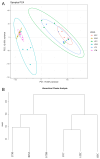Differing Transcriptomic Responses in High Titer versus Low Titer Aedes aegypti Mosquitoes after Oral Infection with Sindbis Virus
- PMID: 39339963
- PMCID: PMC11437473
- DOI: 10.3390/v16091487
Differing Transcriptomic Responses in High Titer versus Low Titer Aedes aegypti Mosquitoes after Oral Infection with Sindbis Virus
Abstract
Oral infection of mosquitoes by arboviruses often results in a large degree of variation in the amount of infectious virus between individual mosquitoes, even when the mosquitoes are from inbred laboratory strains. This variability in arbovirus load has been shown to affect virus transmissibility. Previously, our group described population genetic and specific infectivity differences between the virus populations found in high and low titer Aedes aegypti mosquitoes that had been orally infected with Sindbis virus (SINV). In this study, we sought to investigate whether there were also differences in transcriptomic response between these high and low titer mosquitoes. Results from the transcriptomic data analysis showed that more genes involved in antiviral activity, endopeptidase activity, and methyltransferase activity were upregulated in low titer mosquitoes than in high titer mosquitoes, relative to blood-fed controls. Meanwhile, genes involved in ion transport, energy metabolism, acetylation, glycosylation, lipid metabolism, and transport tended to be upregulated in high titer mosquitoes more than in low titer mosquitoes, relative to blood-fed mosquitoes. Overall, genes involved in antiviral activities tended to be upregulated in low titer mosquitoes while genes involved in proviral activities were mostly upregulated in high titer mosquitoes. This study has identified a number of candidate mosquito genes that are putatively associated with SINV titer variability after oral infection of Ae. aegypti, and these can now be investigated in order to ascertain their roles in virus replication and their contributions to determining vector competence.
Keywords: Aedes aegypti; Sindbis virus; arbovirus; mosquito; vector competence.
Conflict of interest statement
The authors declare no conflicts of interest. The funders had no role in the design of the study; in the collection, analyses, or interpretation of data; in the writing of the manuscript; or in the decision to publish the results.
Figures








References
Publication types
MeSH terms
Associated data
Grants and funding
LinkOut - more resources
Full Text Sources

